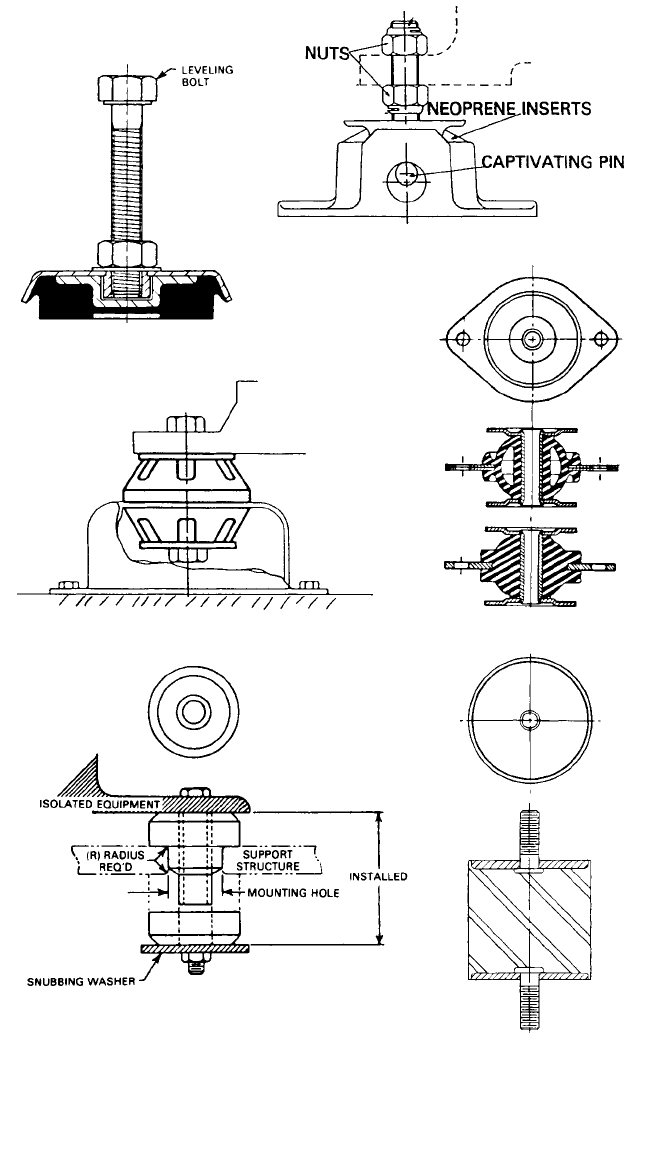Harris C.M., Piersol A.G. Harris Shock and vibration handbook
Подождите немного. Документ загружается.


FIGURE 31.33 Dimensionless representation of maximum force in support
F
1m
resulting from action of impulse J on equipment.
k = 2 = 2 = 123,000 lb/in.
The natural frequency of the machine-and-beams system is
ω
n
=
=
= 75.6 rad/sec [12.0 Hz]
If the impact between the hammer and work is inelastic and its duration is negligi-
ble, the resulting velocity
˙
u
m
of the machine may be found from conservation of
momentum. The impulse J is the product of weight of hammer and time of fall:
J = (600)
1/2
= 335 lb-sec
Then
˙
u
m
= J/m = 335/21.5 = 15.6 in./sec. If the damping of the beams is neglected, the
maximum beam deflection is found from Eq. (31.18):
δ
1m
== =0.21 in.
The maximum force in the beams is the product of beam stiffness and maximum
deflection:
F
1m
= kδ
1m
= 25,300 lb
15.6
75.6
˙
u
m
ω
n
2 × 60
386
123,000
21.5
k
m
48 × (30 × 10
6
) × 302
(18 × 12)
3
48EI
l
3
31.36 CHAPTER THIRTY-ONE
8434_Harris_31_b.qxd 09/20/2001 12:34 PM Page 31.36

b. An isolator having a stiffness k
2
= 36,000 lb/in. and a fraction of critical damp-
ing ζ
2
= 0.10 is interposed between the machine and beams.The “uncoupled natural
frequencies” defined in connection with Eqs. (31.40) and (31.41) are
ω
n2
=
=
= 43.3 rad/sec [6.9 Hz]
ω
n1
=
=
= 230 rad/sec [36.6 Hz]
Consider first that the system is separable. Figures 31.14 and 31.15 give, respectively:
¨
x
2m
/
˙
u
m
ω
n2
= 0.88;
¨
x
2m
δ
2m
/
˙
u
m
2
= 0.76. Substituting
˙
u
m
= J/m
2
= 17.4 in./sec and solving
for δ
2m
,
δ
2m
==0.35 in.
Entering Fig. 31.31 at ω
n1
/ω
n2
= 5.3, F
1m
/Jω
n1
= 0.23. Then
F
1m
= 17,700 lb
Thus, the effect of the isolator is to reduce the maximum load in the beams from
25,300 lb to 17,700 lb.An isolator with less stiffness would permit a further reduction
of this force at the expense of greater machine motion.
Consider now that the floor and machine-isolator systems are coupled, and use
the two degree-of-freedom analysis which neglects damping. From Eq. (31.47):
δ
2m
=
1 +
m
2
/m
1
1 +
2
−1/2
=
1 +
−1/2
= 0.37 in.
From Eq. (31.48):
F
1m
= Jω
n1
1 −
2
+
−1/2
= 335 × 230
(1 − 5.3)
2
+
−1/2
= 14,900 lb
Thus, the two results for the isolator deflection δ
2m
differ only slightly, but the two
degree-of-freedom analysis gives a maximum load in the beams about 16 percent
smaller than that obtained by assuming the systems to be separable.
19.2
2.33
m
2
m
1
ω
n1
ω
n2
19.2/2.33
(1 + 5.3)
2
335
19.2 × 43.3
ω
n1
ω
n2
J
m
2
ω
n2
0.76 × 17.4
0.88 × 43.3
123,000
2.33
k
1
m
1
36,000
19.2
k
2
m
2
THEORY OF SHOCK ISOLATION 31.37
8434_Harris_31_b.qxd 09/20/2001 12:34 PM Page 31.37

CHAPTER 32
SHOCK AND VIBRATION
ISOLATORS AND
ISOLATION SYSTEMS
Romulus H. Racca
Cyril M. Harris
INTRODUCTION
The first part of this chapter is devoted to various types of shock and vibration iso-
lators, as well as their characteristics. The next topic considered is the properties of
combinations of isolators in series and in parallel. A discussion is presented on the
selection, installation, and specification of isolators. Then consideration is given to
isolators that are combined with masses and damping, forming a vibration control
system that can, for example, permit equipment to function as intended, often
lengthening its operable life; protect sensitive equipment mounted on a structure
from damage as a result of shock and vibration occurring in the structure; and
reduce the level of noise and vibration near the equipment, or provide greater com-
fort to nearby occupants of a building.
The last section of this chapter considers the principles of active vibration control
systems that differ from passive (conventional) control systems, described earlier, in
that they supply additional power (controlled by one or more sensors) that is fed
into the system so as to modify its behavior. In many special cases, this additional
complication is worthwhile in that it can provide the system with benefits not other-
wise obtainable.
TYPES AND CHARACTERISTICS OF ISOLATORS
Isolators are commercially available in many different resilient materials, in count-
less shapes and sizes, and with widely diverse characteristics. In the U.S.A. there are
well over 100 elastomeric isolator manufacturers, each offering a range of models in
a variety of synthetic elastomeric compounds and natural rubbers. The number is
32.1
8434_Harris_32_b.qxd 09/20/2001 12:32 PM Page 32.1

significantly higher if manufacturers of plastic, metal, pneumatic, and other-material
isolators are included.
The properties of a given isolator are dependent not only on the material of
which it is fabricated, but also on its configuration and overall construction with
respect to the structural material used within the body of the isolator, as explained
below. Data on these parameters can be found in the catalogs of the various isolator
manufacturers.
ELASTOMERIC ISOLATORS
An elastomer is a natural rubber or any polymer having elastic properties similar to
those of natural rubber, described in detail in Chap. 33. Such materials are widely
used in isolators because they may be conveniently molded into many desired
shapes and selected to provide a wide range of stiffnesses, they have more internal
damping than metal springs, they usually require a minimum of space and weight,
and they can be bonded to metallic inserts adapted for simplified attachment to the
isolated structures.
The most commonly used type of isolator is fabricated of an elastomer. Figure
32.1 illustrates some typical elastomeric isolators. Such isolators are able to sustain
large deformations and then return to their approximate original state with virtually
no damage or change of shape. Elastomeric isolators are superior to other types of
isolators in that, for a given amount of elasticity, deflection capacity, energy storage,
and dissipation, they require less space and less weight; also, they may be molded
into many different configurations of many different types—generally at a lower
cost than other types of isolators.
Elastomers have exceptional extensibility and deformability:They can be utilized
at elongations of up to about 300 percent, with ultimate elongations of some elas-
tomers to about 1000 percent. They may be stressed as much as 1000 to 1500 psi
(0.145 to 0.218 Pa) or more before their elastic limit is reached. Their great capacity
for storing energy permits them to tolerate high stress. Upon release of the stress,
there is virtually total recovery from the deformation.The inherent damping of elas-
tomers is often useful in preventing excessive vibration amplitude at resonance; the
amplitude is much lower than if coil metal springs were used.
Of the various elastomers, natural rubber probably embodies the most favorable
combination of mechanical properties, such as minimum drift, maximum tensile
strength, and maximum elongation at failure. Its usefulness is restricted by its limited
resistance to deterioration under the influence of hydrocarbons, ozone, and high
ambient temperatures. Neoprene and Buna N (nitrile) exhibit superior resistance to
hydrocarbons and ozone, Buna N being particularly satisfactory for applications
involving relatively high ambient temperatures. Buna S is a good general-purpose
synthetic rubber for use in vibration isolators.
Silicone rubber is a costly elastomer. Its properties are remarkably stable, and it
provides effective isolation over a very wide temperature range: −65 to +350°F (−54
to 177°C). By comparison, neoprene is limited in use to a range of about −40 to
+200°F (−40 to 93°C).The upper temperature limit depends on the properties of the
particular compound, the degree of deterioration which is permissible as a result of
continued exposure at high temperatures, and the duration of exposure. For silicone,
a temperature substantially greater than 300°F (149°C) is permissible for several
hours. The outstanding ability of silicone elastomers to withstand extremes of tem-
perature is offset somewhat by their inferior strength, tear resistance, and abrasion
resistance.
32.2 CHAPTER THIRTY-TWO
8434_Harris_32_b.qxd 09/20/2001 12:32 PM Page 32.2

FIGURE 32.1 Typical elastomeric isolators. (A) Machinery mount. (B) Marine engine isolator. (C)
Pedestal isolator. (D) Plate form instrument isolator. (E) General-purpose isolator. (F) Cylindrical
stud isolator.
(A)
(B)
(C)
(E)
(F)
(D)
32.3
8434_Harris_32_b.qxd 09/20/2001 12:32 PM Page 32.3

Isolators fabricated of elastomers are complex in behavior because of the vis-
coelastic nature (somewhere between that of a solid and that of a liquid) of elas-
tomers in performance, because of their indefinite yield point, and because their
physical properties vary with time, temperature, and environment. For example,
rubber is a substantially incompressible material (it has a Poisson’s ratio of approx-
imately 0.5).Thus the stiffness of a rubber spring when it is strained in compression
depends, to a considerable extent, on the area of the surface available for lateral
expansion. In contrast, the stiffness of a rubber spring in shear is substantially inde-
pendent of the shape of the rubber member. As a rough rule of thumb, it may be
assumed that the minimum likely compression stiffness of a given rubber isolator is
five times its shear stiffness. The maximum compression stiffness may be several
times as great as the minimum value if lateral expansion of the rubber is con-
strained.
Fatigue Failure and Premature Failure. Regardless of geometry, both elas-
tomers and metals exhibit fatigue failure as a result of repeated cyclic loadings.
Unlike a metal, an elastomer does not experience catastrophic-type fatigue failure.
Instead, the failure begins as a tear at the point of highest cyclic shear strain, which
is generally on the outer extremity (and therefore visible in many cases), and gradu-
ally propagates through the body of the elastomer.The result is a gradual reduction
in stiffness that usually becomes apparent before there is total failure.
Most elastomeric isolators should not be subject to large static strains over
long periods of time. An isolator with a large static deflection may give satisfactory
performance temporarily, but the deflection tends to creep (increase) excessively
over a long period. In general, elastomers should not be statically strained continu-
ously more than 10 to 15 percent in compression, or more than 25 to 50 percent in
shear.
A factor contributing to the premature failure of an elastomeric isolator is the
effect of the minimum strain on fatigue life. For elastomers which crystallize under
high strains (such as neoprene and natural rubber), fatigue life is greatly increased if
the minimum cyclic stress is always either plus or minus and never passes through
zero. Proper static precompression of the isolator within the limits specified above is
often an effective way to prevent the minimum cyclic stress from passing through
zero under dynamic conditions. Local stress concentrations, which result in prema-
ture failure, often can be avoided by using fillets, radii, and generous overhangs of
the elastomeric section. For example, sharp corners of metal inserts and support
structures should be carefully rounded off wherever they contact the elastomer.
Metal snubbing washers and/or support structures in contact with the elastomer
should be large enough to prevent their edges from cutting into the elastomeric sur-
faces.
Bonded versus Unbonded Elastomeric Isolators. Elastomeric isolators may be
designed in both bonded and unbonded configurations. In the bonded isolator, metal
inserts are bonded to the elastomer on all load-carrying surfaces. In the unbonded or
semibonded isolator, the elastomeric load-bearing surface rests directly on the sup-
port structure. Bonded parts usually cost more because of the special chemical prepa-
ration required to achieve a bond with strength in excess of that of the elastomer
itself. Bonded parts are generally preferred since they may be more highly stressed
for a given deflection. With higher stress they provide higher spring constants and
higher elastic energy-storage capacity.
Bonded isolators can be designed to provide proper load distribution in shear,
compression, tension, or combination loading.A more uniform stress distribution in
32.4 CHAPTER THIRTY-TWO
8434_Harris_32_b.qxd 09/20/2001 12:32 PM Page 32.4

the elastomer is obtained by bonding inserts on all the load-bearing elastomer sur-
faces.The bonded inserts reduce unit stress by distributing the stress more uniformly
throughout the volume of the elastomer. In contrast, unbonded parts usually fail to
distribute the load uniformly, resulting in local areas of stress concentration in the
elastomer body which shorten the life of the isolator.
A significant difference between bonded and unbonded elastomeric isolators
relates to how elastomers behave under load.When an elastomer pad is compressed
under load, its volume remains constant—only its shape is changed. The rubber
“bulges” under load. When this ability to bulge is controlled, the load-deflection
characteristics of the isolator are controlled. In a bonded isolator, the load-carrying
surfaces have a fixed degree of bulge because the elastomer cannot move along the
bond line, and so it remains in a fixed position regardless of the load or environ-
mental conditions.
In an unbonded isolator, this is not the case. The ability of the elastomer to bulge
depends to a considerable degree on the maintenance of friction at the elastomer–sup-
port structure interface. When all surfaces are clean and dry, the difference between
the ability of a bonded and an unbonded isolator to bulge is negligible. But if oil or
sand works its way into the elastomer-to-metal interface of the unbonded isolator, the
ability of the elastomer to bulge is greatly increased; consequently, its original load-
deflection characteristics no longer exist.Then the isolator can exhibit load-deflection
characteristics that are 50 percent less than when it was new; in many cases, this can
cause the isolator to malfunction. Thus, where consistent load-deflection characteris-
tics are required for the life of the equipment, bonded isolators should be used.
Although the initial cost of unbonded isolators is lower, in many applications the
cost of extra machining of the support structure and the reduced service life may well
make unbonded isolators a poor selection.
Types of Isolator Loading. Elastomer isolators may be used with different types
of loading: compression, shear, tension, or buckling, or any combination of these
types.
Compression Loading. The word compression is used to indicate a reduction in
the dimension (thickness) of an elastomeric element in the line of the externally
applied force. The stiffness characteristic of elastomers stressed in compression
exhibit a nonlinearity (hardening) which becomes especially pronounced for strains
above 30 percent. Compression loading, illustrated in Fig. 32.2A, is most effective
when used with simple unbonded isolators and is effective where gradual snubbing
(motion limiting) is required. Compression loading is frequently employed to pro-
vide a low initial stiffness for vibration isolation and a relatively high final stiffness
to limit the dynamic deflection under shock excitations. Because of the nonlinear
hardening characteristics of compression loading, it is the least effective type of
loading for energy storage and therefore is not recommended where the attenuation
of force or acceleration transmission is the primary concern. (The energy stored by
any spring is the area under the load-deflection curve.)
Shear Loading. Shear loading, illustrated in Fig. 32.2B, refers to the force
applied to an elastomeric element so as to slide adjacent parts in opposite directions.
An almost linear spring constant up to about 200 percent shear strain is characteris-
tic of elastomer stress in shear. Because of this linear spring constant, shear loading
is the preferred type of loading for vibration isolators because it provides a constant
frequency response for both small and large dynamic shear strains in a simple
spring-mass system. Shear loading is also useful for shock isolators where attenuat-
ing force or acceleration transmission is important, because of its more efficient
energy-storage capacity when compared to compression loading. However, care
SHOCK AND VIBRATION ISOLATORS AND ISOLATION SYSTEMS 32.5
8434_Harris_32_b.qxd 09/20/2001 12:32 PM Page 32.5

must be taken to ensure that the expected dynamic loads do not result in shear
strains that exceed the limits of the elastomer or that abrupt bottoming of the sup-
ported equipment does not occur.
Torsion Loading. A modification of shear loading that is sometimes listed as a
separate type is torsion loading, shown in Fig. 32.2C. It consists of winding up a sand-
wich of laminated sections to strain the elastomer in torsion. When the strain in tor-
sion exceeds about 150 percent, considerable axial thrust loads on connecting
members are induced, if they are rigidly fixed parallel to each other, because of the
reduction in the axial thickness of the elastomer.
Tension Loading. Tension loading, illustrated in Fig. 32.2D, refers to an
increase in the dimension (thickness) of an elastomeric element in the line of the
externally applied force. Elastomers stressed in tension exhibit a nonlinear (soften-
ing) spring constant. For a given deflection, tension loading stores energy more effi-
ciently than either shear or compression loading. Because of this, tension loading has
32.6 CHAPTER THIRTY-TWO
FIGURE 32.2 Load-deflection characteristics of typical elastomeric
isolators.
8434_Harris_32_b.qxd 09/20/2001 12:32 PM Page 32.6

been occasionally used for shock isolation systems. However, in general, tension
loading is not recommended because of the resulting loads on the elastomer-to-
metal bond, which may cause premature failure of the material.
Buckling Loading. Buckling loading, illustrated in Fig. 32.2E, occurs when
the externally applied load causes an elastomeric element to warp or bend in the
direction of the applied load. Buckling stiffness characteristics may be used to
derive the benefits of both softening stiffness characteristics (for the initial part of
the load-deflection curve) and hardening characteristics (for the later part of the
load-deflection curve). The buckling mode thus provides high energy-storage
capacity and is useful for shock isolators where force or acceleration transmission
is important and where snubbing (i.e., motion limiting) is required under exces-
sively high transient dynamic loads.This type of stiffness characteristic is exhibited
by certain elastomeric cushioning foam materials and by specially designed elas-
tomeric isolators. However, it is important to note that even simple compressive
elements will buckle when the slenderness ratio (the unloaded length/width ratio)
exceeds 1.6.
Combinations of the types of loading described above are commonly used, which
result in combined load-deflection characteristics. Consider, for example, a com-
pression-type isolator which is installed at an angle instead of in the usual vertical
position. Under these conditions, it acts as a compression-shear type of isolator
when loaded in the vertical downward direction.When loaded in the vertical upward
direction, it acts as a shear-tension combination type of isolator.
Static and Dynamic Stiffness. When the main load-carrying spring is made of
rubber or a similar elastomeric material, the natural frequency calculated using the
stiffness determined from a static load-deflection test of the spring almost invariably
gives a value lower than that experienced during vibration. Thus the dynamic mod-
ulus appears greater than the static modulus. The ratio of moduli is approximately
independent of the velocity of strain, and has a numerical value generally between 1
and 3. This ratio increases significantly as the durometer increases.
Damping Characteristics. Damping, to some extent, is inherent in all resilient
materials. The damping characteristics of elastomers vary widely. A tightly cured
elastomer may (within its proper operating range) store and return energy with
more than 95 percent efficiency, while elastomers compounded for high damping
have less than 30 percent efficiency. Damping increases with decreasing temperature
because of the effects of crystallinity and viscosity in the elastomer. If the isolator
remains at a low temperature for a prolonged period, the increase in damping may
exceed 300 percent. Damping quickly decreases with low-temperature flexure,
because of the crystalline structure deterioration and the heat generated by the high
damping.
Where the nature of the excitation is difficult to predict (for example, random
vibration), it is desirable that the damping in the isolator be relatively high. Damp-
ing in an isolator is of the greatest significance at the resonance frequency. There-
fore, it is desirable that isolators embody substantial damping when they may
operate at resonance, as is the case when the excitation is random over a broad fre-
quency band or even momentary (as in the starting of a machine with an operating
frequency greater than the natural frequency of the machine on its isolators). The
relatively large amplitude commonly associated with resonance does not occur
instantaneously, but rather requires a finite time to build up. If the forcing frequency
is varied continuously as the machine starts or stops, the resonance condition may
exist for such a short period of time that only a moderate amplitude builds. The rate
SHOCK AND VIBRATION ISOLATORS AND ISOLATION SYSTEMS 32.7
8434_Harris_32_b.qxd 09/20/2001 12:32 PM Page 32.7

of change of forcing frequency is of little importance for highly damped isolators, but
it is of considerable importance for lightly damped isolators.
In general, damping in an elastomer increases as the frequency increases. The
data of Figs. 33.5 and 33.6 can be used to predict transmissibility at resonance by esti-
mating the frequency and the amplitude of dynamic shear strain; then the fraction of
critical damping is obtained from the curves and used with Eq. (30.1) to calculate
transmissibility at resonance.
Hydraulically Damped Vibration Isolators. Hydraulically damped vibration
isolators combine a spring and a damper in a single compact unit that allows tun-
ing of the spring and damper independently. This provides flexibility in matching
the dynamic characteristics of the isolator to the requirements of the application.
Hydraulic mounts have been used primarily as engine and operator cab isolators
in vehicular applications. The hydraulically damped isolator, described in Ref. 2,
has a flexible rubber element that encapsulates an incompressible fluid which
is made to flow through a variety of ports and orifices to develop the dynamic
characteristics required. The fluid cavity is divided into two chambers with an ori-
fice between, so that motion of the elastomeric element causes fluid to flow from
one chamber to the other, dissipating energy (and thus creating damping in the
system).
Installations that require a soft isolator for good isolation may also require
motion control under transient (shock) inputs or when operating close to the isola-
tion system’s resonant frequency. For good isolation, low damping is required. For
motion control, high damping is required. Fluid-damped isolators accommodate
these conflicting requirements. A hydraulically damped vibration isolator can also
act as a tuned absorber by increasing the length of the orifice into an inertia track
because the inertia of the fluid moving within the isolator acts as a tuned mass at a
specific frequency (which is determined by the length of the orifice).This feature can
be used where vibration isolation at a particular frequency is required.
PLASTIC ISOLATORS
Isolators fabricated of resilient plastics are available and have performance charac-
teristics similar to those of the rubber-to-metal type of isolators of equivalent con-
figuration.The structural elements are manufactured from a rigid thermoplastic and
the resilient element from a thermoplastic elastomer. These elements are compati-
ble in the sense that they are capable of being bonded one to another by fusion. The
most commonly used materials are polystyrene for the structural elements and buta-
diene styrene for the resilient elastomer.The advantages of this type of spring are (1)
low cost, (2) exceptional uniformity in dynamic performance and dimensional sta-
bility, and (3) ability to maintain close tolerances. The disadvantages are (1) limited
temperature range, usually from a maximum of about 180°F (82°C) to a minimum of
−40°F (−40°C), (2) creep of the elastomer element at high static strains, and (3) the
structural strength of the plastic.
METAL SPRINGS
Metal springs are commonly used where large static deflections are required, where
temperature or other environmental conditions make elastomers unsuitable, and (in
some circumstances) where a low-cost isolator is required. Pneumatic (air) springs
32.8 CHAPTER THIRTY-TWO
8434_Harris_32_b.qxd 09/20/2001 12:32 PM Page 32.8
